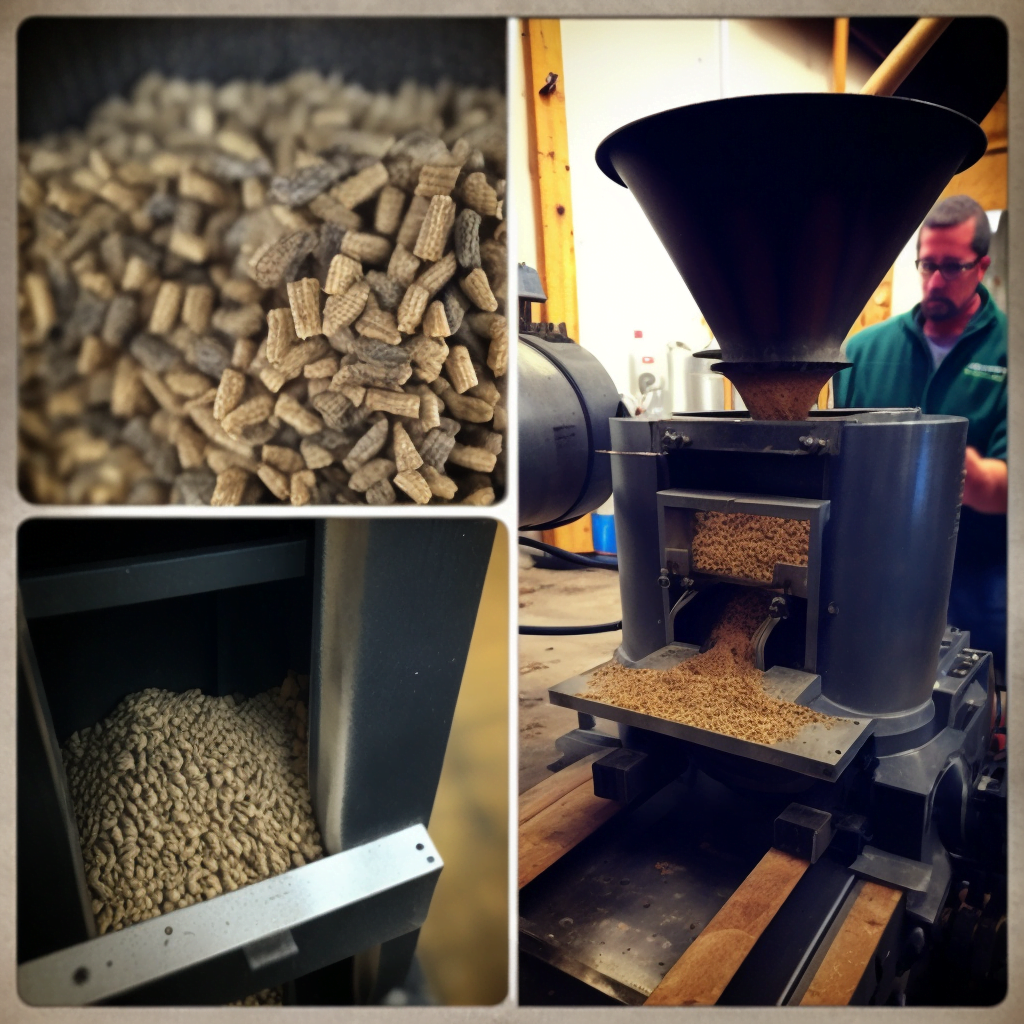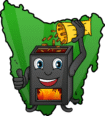Ever had different types of pellets, maybe a bag left over, and wondered can you mix hardwood and softwood pellets? The short answer is yes, you can mix both types of pellets together and it will not harm your pellet heater in anyway. I’ll tread carefully here because I know the topic of hardwood and softwood pellets is a touchy one and people have their own preferences on what burns better. Generally speaking, people like softwood because it burns hotter and has less ash than hardwood pellets. I, however, will burn whatever pellets are on sale but there are actually some benefits to be had from mixing softwood and hardwood pellets together which may improve your burn.

You can mix hardwood and softwood pellets and here’s why you might want to and the benefits of mixing the two types of pellets:
- Cleaner burn, less ash
- Saves money
- Helps with poor quality pellets
Different Types of Pellets
To understand why you would mix hardwood and softwood pellets, let’s take a look at the differences between these two. I’ve written about this in a hardwood vs softwood pellets post, but here’s a summary. Softwood typically burns hotter than hardwood, meaning you get slightly more heat created when softwood is burnt. This is the main reason why some people prefer to burn softwood because they believe they are getting more heat out of it. There’s plenty of research and information online that does indeed support this. In addition to burning hotter, softwood also produces less ash than hardwood. So, in addition to more heat you also get a “cleaner” burn because there’s less ash left over.
That’s the main argument from people who prefer to burn softwood pellets. They state that if you buy a bag of softwood pellets you are going to get more heat than you would from a bag of hardwood pellets, so your house is warmer, and you get less ash in your pellet heater, meaning your pellet heater is cleaner and will run better. Basically they think the quality of burn and heat is better than hardwood pellets. I don’t disagree with that (softwood technically burns hotter), however, I don’t think it is relevant when it comes to pellet heaters.
Pelletizing Softwood and Hardwood Pellets
The type wood used to create wood pellets isn’t important to me because what happens during the process of making pellets, pelletizing, where raw wood material, such as sawdust, is turned into pellets. This process creates compact wood pellets, which are extremely high in energy content that is turned into heat when burnt. Bags of pellets are the same or nearly the same size. Meaning a 15kg bag of softwood pellets is basically the same size and weighs the same as a 15kg bag of hardwood pellets. Compare this to firewood where a ute full of softwood will weigh less than a ute full of hardwood. This is because hardwood is much denser and contains more energy.
Because of how wood pellets are made, you’ll find no more than 10% difference in heat between softwood and hardwood pellets. So, yes, softwood burns hotter but it’s minimal at best. However, what you will often find is a huge difference in price. If you buy softwood pellets in Tasmania, as of February 2023 you’ll pay around $12 a bag. Buy hardwood pellets in Tasmania and you’ll pay as little as $8.50. That’s a difference of 30% in price for about 10% heat gain. Even if it was a difference of 20% in heat you are still paying more for diminishing returns of heat. It’s not worth it, at least to me.
Why Burn Softwood Pellets
So if hardwood and softwood pellets contain the same or only a marginal difference in heat, then why bother burning softwood pellets, especially if they cost more? I think the may reason is people like the cleaner burn softwood pellets produce. You’ll get slightly less ash and possibly not as many clinkers while burning softwood pellets. You’ll probably also notice a cleaner glass door on your pellet heater which won’t get as dirty as quick, due to the cleaner burn. I personally don’t mind cleaning my pellet heater, but I understand some people are happy to pay the extra price for a cleaner burn knowing there is less ash building up in their pellet heater, making it easier to clean.
Also, this cleaner burn is completely dependent on the quality of the raw material being used to make the wood pellets. A good example is there’s a very popular hardwood pellet brand in Tasmania that burns extremely clean. You can run your heater all week and there’ll be almost no ash in the burn box and glass door will still be very clean. Even though the pellets are made from hardwood, they burn so clean because the wood waste used to make the pellets is extremely clean (few impurities) and high quality. As a result the hardwood pellets burn super clean, much like softwood pellets.
Why Burn Hardwood Pellets
OK, so why bother with hardwood pellets if softwood pellets burn hotter and cleaner? The main reason is the price difference between these two types of pellets. While you may get slightly less heat, you’ll also save money. I burn about 80 bags a year. If I save $3 per bag by buying hardwood pellets, then that is a saving of $240 a year. That’s enough to pay to get my pellet heater serviced, even though I do it myself, but hopefully you get my point. There’s a considerable saving to be had by burning hardwood pellets. However, you will get slightly more ash and possibly clinkers. I don’t mind because cleaning a pellet heater is part of owning one.
As above, not all hardwood pellets burn “dirty” but you will find that the cheaper pellets are made from hardwood and price definitely does give you an indication of the quality and how well they burn. This doesn’t mean they are crap and won’t burn but it does mean you’ll be cleaning the glass door and burn box more than you would with more expensive, higher quality pellets. I guess you need to decide. Are you happy to pay extra for a cleaner burn or save some money and do a little more cleaning.
Benefits from Mixing Hardwood and Softwood Pellets
So with the difference between hardwood and softwood pellets out of the way, why would anyone bother to mix hardwood and softwood pellets together? It’s worthwhile mixing these two types of pellets for the reasons listed above. You’ll get a cleaner burn, you can save money and it will help with poor quality pellets, which will again give you a cleaner burn and save money, quite a lot of money.
Mixing Pellets for a Cleaner Burn
Some wood pellet mills make not only hardwood pellets and softwood pellets but they also make a mixture of the two. These pellets contain both hardwood and softwood usually in a 50/50 or 70/30 mix. They do this because the pellets burn cleaner than hardwood but also aren’t as expensive. However, if you can’t buy mixed pellets then it is easy to do yourself. The benefit of mixing them is you get a cleaner burn. This isn’t to say hardwood pellets are terrible, produce excessive ash and will block up your heater. But by mixing hardwood and softwood pellets you will most likely get less ash, fewer clinkers and won’t need to clean the glass door as much.
Mixing Pellets to Save Money
The other reason to mix hardwood and softwood pellets is to save money. Hardwood pellets cost me $8.50 and softwood $12.00 a bag. If I mixed them at a ratio of 50/50, then a bag of pellets now costs me $10.25. That isn’t as cheap as $8.50 but it’s cheaper than $12.00. So you’ll save money compared to burning purely softwood pellets but at the same time you will get a cleaner burn when compared against burning purely hardwood pellets. It’s basically the best of both worlds and this is why some pellet mill make wood pellets that are a mixture of both types of wood. You get a slightly hotter and cleaner burn but also save money.
Mixing Pellets to Fix Pellet Quality
Another reason to mix hardwood and softwood pellets is due to poor pellet quality. Pellet quality is very important and it’s why I say people should focus on buying pellets that are at a price that suits them and of good quality. What happens during the process of making pellets will affect how well they burn. If a bag of softwood pellets contains impurities, like bark, then those pellets will burn poorly and probably produce a lot of clinkers. This is why you shouldn’t buy a tonne of pellets without testing them first. But if you do end up with a heat of pellets that burn poorly then mixing them will help solve the problem.
By mixing poor quality pellets with another type, it could be softwood and softwood or hardwood and softwood, you will improve the burn. Basically you are mixing good pellets with bad pellets. The result is you improve the burn. Why do this? Well, if you bought a tonne of pellets and didn’t test the quality first, then you may have ended up with some pretty crap pellets. Poor quality pellets is the primary cause of clinkers and ash. Instead of throwing them away and wasting all that money, you can “water them down” with another brand of pellet that burns better.
Should I Only Burn Hardwood Pellets in My European Pellet Heater?
It doesn’t matter what brand, model or type of pellet heater you have. If you own a Piazzetta pellet heater or Palazzetti pellet heater, then you can burn whatever pellets you want, the same goes for Chinese made pellet heaters. Burning a more expensive pellet that produces less ash might be something to consider. I can understand why you’d want to burn a pellet that produces less ash in a European heater which might cost $10,000. In this case you want a cleaner burn so find a pellet that is good quality and burns clean. It won’t matter if it is hardwood or softwood.
Should You Mix Hardwood and Softwood Pellets
So is it worth mixing hardwood and softwood pellets? If you have pellets that burn poorly but don’t want to throw them away, then definitely mix them with other pellets. If they burn really poorly then you may go a 70/30 mixture to improve the burn. However, since I am happy to burn hardwood pellets and I can buy pellets that are already a 50/50 mix of hardwood and software, I personally don’t bother mixing pellets because it’s a waste of time. If you want a cleaner burn, want to save money and don’t mind spending the time to mix the pellets, then definitely do it, you will notice a difference but it’s just not for me.
Resources
Heating values of wood pellets from different species
